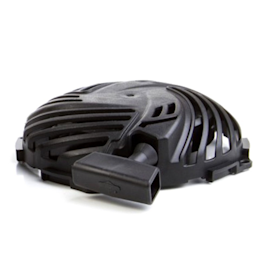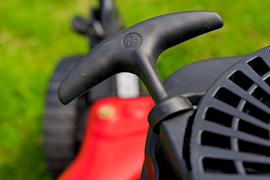How to winterize a lawn mower


At the end of mowing season, resist the temptation to shove the mower to the back of the garage and forget about it. By spending an hour with it now, it will be easier to get it ready in spring, when the grass suddenly starts growing.
If you need help with other mower issues, our DIY walk-behind mower repair page has symptom advice, troubleshooting videos, repair guides and maintenance articles. Once you’ve diagnosed the problem, find the part you need on our lawn mower parts page.
Let's get started.
1. Gather the supplies you need
Cleaning brushes, scraper and rags
Air filter, if needed
Drive belt, if needed
Lubricant recommended in the owner's manual
2. Use up the gas
Unless you treated the gas with a a gasoline stabilizer/conditioner, run the mower to use up the remaining gas (use the mower to chop up the leaves on your lawn so you don't have to rake!). Don't leave untreated gas in the mower over the winter, because the gas deteriorates, and the mower might not start in spring.
If there is treated gas in the tank, remove the gas cap, cover the opening with a plastic food storage bag, and screw the gas cap on over the bag. The covering keeps the gas from leaking when you clean under the mower in the next step.
3. Clean the mower body
Let the mower cool after you use up the gas and then disconnect the spark plug wire so the mower can’t start accidentally while you work on it.
Clean the top of the mower by brushing off loose dirt, grass and dust. Then wipe with a damp cloth.
Tilt the mower on its side with the air filter up, so oil won’t leak into the cylinder.
Scrape the underside of the mower to remove grass deposits. A putty knife works well, but if you’re concerned about scratching the finish, use a hard plastic ice scraper. Clean dirt and grass clumps off the wheels too. Then turn the mower upright. Manufactures don’t recommend using a garden hose to clean the mower unless you cover the electrical system, muffler, air filter and carburetor to keep water out.
Remove the air filter. If you replaced it earlier in the season, just gently tap off loose dirt. Replace the filter if excess dirt doesn't come off, or if you’ve not replaced it this season.
Clean under the drive cover. Brush out any debris and scrape the underside of the cover. For instructions on removing the drive cover, see the repair guide and video How to replace a lawn mower drive cable.
Use a hard stream of water from the hose to clean the grass catcher. Let it dry completely.
4. Tighten fasteners and belts
Tighten loose nuts and other fasteners.
On belt-driven mowers, tighten the belts as needed and check for excessive wear or cracks. Replace damaged belts.
5. Store the mower
Put the mower away in a dry place. To keep the outside clean and to protect it from damage-causing moisture, you can cover it with a mower cover, or a waterproof tarp. If storing the mower in an area with poor ventilation, use a light oil to coat the lawn mower—especially moving parts and the cables—to prevent rust.
Symptoms for gas walk-behind mowers
Choose a symptom to see related walk-behind mower repairs.
Main causes: damaged cutting blade, loose cutting blade, damaged flywheel key, engine needs tune up…
Main causes: uneven wheel height settings, damaged wheel, dull or damaged cutting blade…
Main causes: engine needs tune up, dirty or clogged carburetor, damaged flywheel key…
Main causes: drive control cable failure, worn or broken drive belt, bad transmission, broken drive wheel…
Main causes: stale gas, engine needs tune up, bad spark plug, dead battery, bad recoil starter, faulty safety switch, ba…
Main causes: dirty carburetor, bad spark plug, clogged air filter, engine choke problems, clogged gas cap vent…
Repair guides for gas walk-behind mowers
These step-by-step repair guides will help you safely fix what’s broken on your walk-behind lawn mower.

How to rebuild a lawn mower carburetor
The carburetor mixes air with fuel to drive the piston. Rebuild the carburetor if it's clogged or leaks.…

How to replace a lawn mower recoil starter on an OHV engine
Replace the recoil starter if it doesn't move when you pull the starter rope.…

How to replace a lawn mower wheel
Learn how replace a damaged wheel on a walk-behind lawn mower—it's a quick, easy fix.…
Articles and videos for gas walk-behind mowers
Use the advice and tips in these articles and videos to get the most out of your walk-behind lawn mower.

Learn about all the convenient features on our Sears PartsDirect website that make your parts purchases easier.…

Get answers to frequently asked questions about Sears and Sears PartsDirect.…

A blade obstruction, bad recoil starter or locked-up engine can prevent the pull cord on your mower from working. See ho…